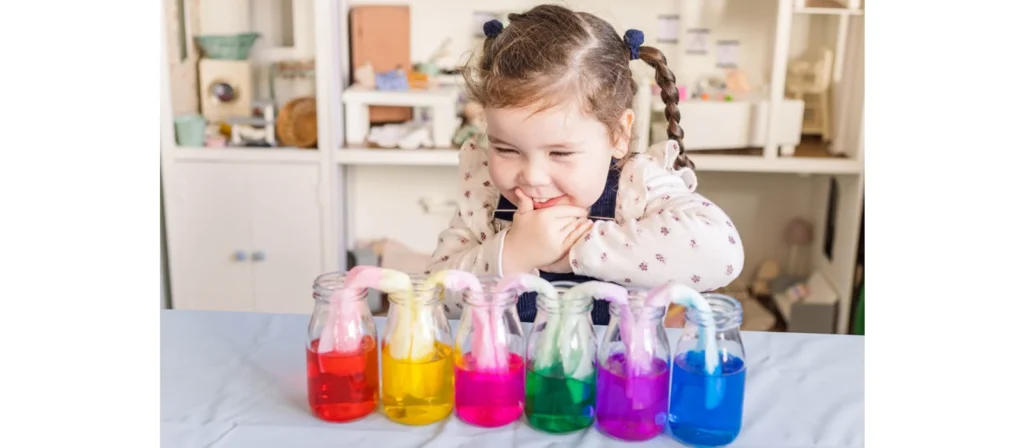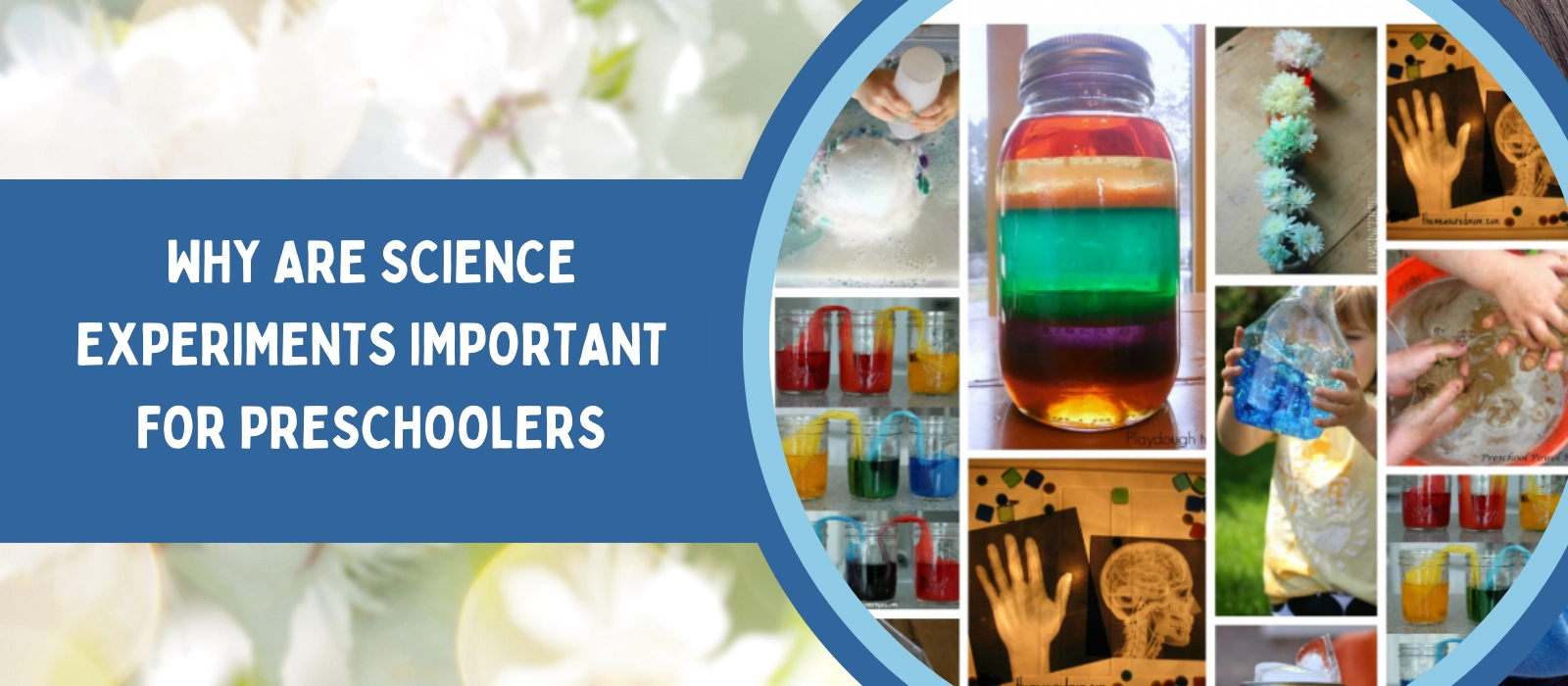Have you ever watched a child’s eyes widen at a bubbling “volcano” and wondered if that moment really matters? Do simple kitchen experiments actually shape thinking? Are we missing a chance to build curiosity, confidence, and language every time we skip science during play?
Yes—preschool science experiments matter deeply. When children mix, pour, compare, and predict, they’re not just making a mess. They’re wiring their brains for reasoning, building vocabulary, and learning to collaborate. With safe, simple materials and a little structure, we can turn everyday moments into powerful lessons that support cognitive growth, problem-solving, and creativity—without expensive equipment or complex setups.
Stick with me. I’ll show you why these tiny experiments create big outcomes—and how to make them safe, joyful, and effective in any preschool setting.
Why Are Science Experiments Important For Preschoolers
1. Promotes Cognitive Development
- Science experiments help children understand cause and effect, enhancing their observation and critical thinking skills.
- Through hands-on activities, kids learn fundamental scientific concepts like the properties of materials and reactions.
2. Enhances Problem-Solving Skills
- Children learn to ask questions, make predictions, and test their ideas during experiments, which fosters problem-solving abilities.
- Repeated experimentation teaches them that failure is part of learning, building patience and adaptability.
3. Fosters Creativity and Curiosity
- Science experiments provide opportunities for exploration and creativity, allowing children to hypothesize and test their own ideas.
- Hands-on activities spark curiosity and help kids actively explore the world around them.
4. Improves Language and Communication Skills
- During experiments, children describe their observations, enhancing their verbal expression.
- Working with others on experiments helps develop social skills and teamwork abilities.
5. Connects to the Real World
For example, in a sink or float experiment, children can directly observe how objects behave in water, helping them understand concepts like “buoyancy” and “density.”
Many science experiments are based on real-world natural phenomena or everyday objects, helping children link abstract scientific concepts to their daily lives.

How Preschool Science Experiments Foster Creativity and Critical Thinking
Preschool science experiments are a powerful tool for nurturing creativity and critical thinking skills in young learners. By engaging in hands-on activities, preschoolers are encouraged to think outside the box and explore new ideas. These preschool science experiments stimulate their imagination and allow them to experiment freely, which is essential for developing innovative thinking. Through simple yet effective science experiments for preschoolers, children learn to approach problems with a creative mindset and find unique solutions.
One of the key aspects of preschool science experiments is that they promote inquiry-based learning. When children conduct easy science experiments for preschoolers, such as mixing colors or watching a balloon inflate with baking soda and vinegar, they begin to ask questions like “What happens if…?” or “Why did that happen?” This fosters their ability to think critically about the world around them. These preschool activities science experiments naturally lead to discussions about cause and effect, helping children make connections between actions and outcomes.
As children experiment with different materials and observe the results, they develop problem-solving skills. For example, a science experiment for preschoolers involving water and different objects—such as the classic sink or float science experiment for preschoolers—helps children predict and test whether certain objects will sink or float. Through trial and error, preschoolers learn how to evaluate their predictions, adjust their ideas, and think critically about their observations. These types of simple science experiments for preschoolers provide the perfect opportunity for children to understand the importance of persistence and flexibility in the problem-solving process.
Moreover, fun science experiments for preschoolers like creating a rainbow using food coloring or exploring the properties of magnets also encourage children to think creatively. They are not just following instructions; they are actively engaging with the materials, observing the effects, and coming up with their own questions and hypotheses. These types of science experiments preschoolers engage both the right side (creative thinking) and left side (logical thinking) of the brain, leading to a more balanced development of critical and creative thinking skills.
By participating in easy preschool science experiments, children also learn to collaborate with their peers, which is a vital skill in both school and life. Many preschool science experiments can be done in small groups, where children share materials, communicate ideas, and work together to find answers. This cooperative learning fosters social skills, teamwork, and encourages them to approach problems from multiple perspectives.
In addition, science experiments for preschoolers with water or even apple science experiments for preschoolers allow young children to test different hypotheses and make discoveries on their own. Whether it’s experimenting with baking soda science experiment preschool or testing how different liquids behave when mixed, preschoolers learn that science isn’t just about following a set of instructions—it’s about exploring the unknown and coming to their own conclusions.
These experiments also provide opportunities for preschool spring science experiments or even halloween science experiments for preschoolers, where creativity can be expanded to incorporate the themes and colors of the season. For instance, a pumpkin science experiment preschool could involve observing how pumpkins change over time, sparking curiosity about natural processes. These seasonal experiments enhance children’s connection to the world around them, linking their learning to real-world experiences.
Ultimately, the ability to engage in hands-on science experiments for preschoolers builds a foundation of critical thinking and creativity that will benefit children throughout their educational journey. By experimenting with simple tools, materials, and ideas, preschoolers not only grasp scientific concepts, but also develop the mindset needed to become lifelong learners. These easy science experiments for preschoolers at home or in the classroom encourage exploration, foster a love for science, and promote independent thinking.
As children grow older, these early experiences with preschool science experiments will serve as a springboard for more advanced scientific inquiry, allowing them to tackle increasingly complex challenges with confidence and creativity.
The Best Materials for Preschool Science Experiments: Safe and Simple
When conducting preschool science experiments, selecting the right materials is crucial. The best materials should be safe, easy to handle, and accessible. Many excellent preschool science experiments can be done using common household items, making them both affordable and easy to set up.
Everyday materials like baking soda, vinegar, and food coloring are perfect for simple science experiments for preschoolers. For example, using water and various objects in a sink-or-float experiment can introduce children to basic scientific principles like density and buoyancy. These materials are not only safe but provide endless opportunities for hands-on learning.
Natural items like leaves, flowers, and seeds can also be used in preschool science experiments, especially when exploring the changing seasons or the science behind plant growth. Simple experiments like examining how leaves change color or testing how different materials absorb water help children connect science to the world around them.
Tools such as magnifying glasses, small measuring cups, and droppers are also great additions. These items allow preschoolers to engage in activities that help develop fine motor skills while learning basic measurement and observation techniques.
Incorporating simple, safe materials into preschool science experiments allows children to explore and learn without needing complex or expensive equipment. The best materials are those that encourage curiosity and hands-on exploration, making science fun and accessible to young learners.
How to Make Preschool Science Experiments More Interactive and Fun
Making preschool science experiments interactive and fun is essential for engaging young learners and helping them retain the scientific concepts being introduced. The more children are involved in the process, the more they can explore, discover, and truly understand the principles at play. Here are some tips on how to make preschool science experiments more engaging, interactive, and enjoyable for young children.

1. Encourage Hands-On Exploration
The best way to make science experiments interactive is by allowing children to engage directly with the materials. Instead of simply observing the experiment, encourage them to participate by pouring liquids, mixing substances, or using tools to manipulate objects. For example, in a simple sink-or-float experiment, let the children drop objects into the water themselves. The more they handle the materials, the more engaged they will be in the experiment.
2. Ask Open-Ended Questions
Asking open-ended questions during preschool science experiments can spark curiosity and encourage critical thinking. Instead of simply telling children what is happening, ask them questions like, “What do you think will happen next?” or “Why do you think this object floats?” These questions prompt children to think, make predictions, and test their ideas, making the experiment more interactive and educational.
3. Incorporate Storytelling
Adding a fun story to the experiment can help capture children’s attention and make the science lesson more relatable. For example, when doing a preschool volcano science experiment, tell a story about a scientist discovering a volcano or a character in a fantasy world who is exploring the eruption. Storytelling brings an imaginative element to the experiment, helping children connect emotionally and cognitively to the activity.
4. Use Props and Visual Aids
Visual aids and props can make a science experiment more exciting and help children better understand abstract concepts. For example, using a toy dinosaur or animal figures to demonstrate a dinosaur science experiment for preschoolers adds a visual element that can make the concept more concrete. Colorful charts, diagrams, and videos can also be useful in demonstrating complex ideas in a way that young children can grasp.
5. Make It Seasonal
Linking experiments to the seasons makes them more relatable and engaging for preschoolers. For example, you can do fall science experiments for preschoolers with pumpkins or leaves, or spring science experiments preschool related to flowers and plant growth. This makes the experiment feel connected to the world around them and encourages them to explore the changes in nature.
6. Use Music and Movement
Incorporating music and movement into science experiments makes them more dynamic and fun. You can create a “science dance” that corresponds to the actions of the experiment, or play a fun song while children conduct the experiment. For example, if you’re doing a bubble science experiment for preschoolers, you can play a song about bubbles or have the children wiggle and jump as they watch the bubbles float. This not only makes the experiment more fun but also helps children develop coordination and rhythm.
7. Let Children Predict Outcomes
Before starting an experiment, allow children to make predictions about what they think will happen. This can be as simple as guessing what color a liquid will turn when mixed or how high a balloon will fly when filled with air. Having children voice their predictions encourages them to think critically about the experiment and gives them a sense of ownership over the process. Afterward, you can compare the predictions with the actual outcome and discuss any surprises.
8. Provide Opportunities for Exploration After the Experiment
After completing a preschool science experiment, allow children time to explore further on their own. For example, after a color mixing science experiment for preschoolers, give them extra materials to experiment with independently and see what new colors they can create. This open-ended exploration gives children the freedom to experiment on their own terms and reinforces the learning from the original experiment.
9. Celebrate Success and Discovery
Celebrating each small discovery or success during the experiment is a great way to keep preschoolers motivated and excited. Whether it’s the first time a child sees a bubble pop or watches a seed sprout, celebrating these moments helps build a positive association with science. Encourage children to talk about what they learned and share their discoveries with others, fostering a sense of pride in their achievements.
10. Make It Collaborative
Allow children to work together during preschool science experiments. Collaboration helps develop social skills and encourages children to share ideas and solve problems as a team. You can assign roles or tasks to different children, such as mixing ingredients, making predictions, or recording observations. This not only makes the experiment more interactive but also teaches children how to work together and communicate effectively.
By incorporating these tips into your preschool science experiments, you can make learning more engaging, interactive, and fun. When children are actively involved in the process, they gain a deeper understanding of the scientific concepts at hand and develop a lifelong love for learning. These interactive approaches also help foster creativity, critical thinking, and problem-solving skills, which are essential for their future education.
Conclusion
At XIHA Furniture, we turn preschool science into everyday magic. As a factory-direct, one-stop B2B supplier of kindergarten furniture and toys, we design safe, durable STEM corners, sensory tables, and storage that make experiments easy—and classrooms beautiful. Our products meet international standards (CE/ASTM) and ship on reliable timelines at competitive prices. If you’re planning a new lab nook or refreshing your discovery area, let’s build it together. Contact me at info@xihafurniture.com—your science-ready classroom starts here.



